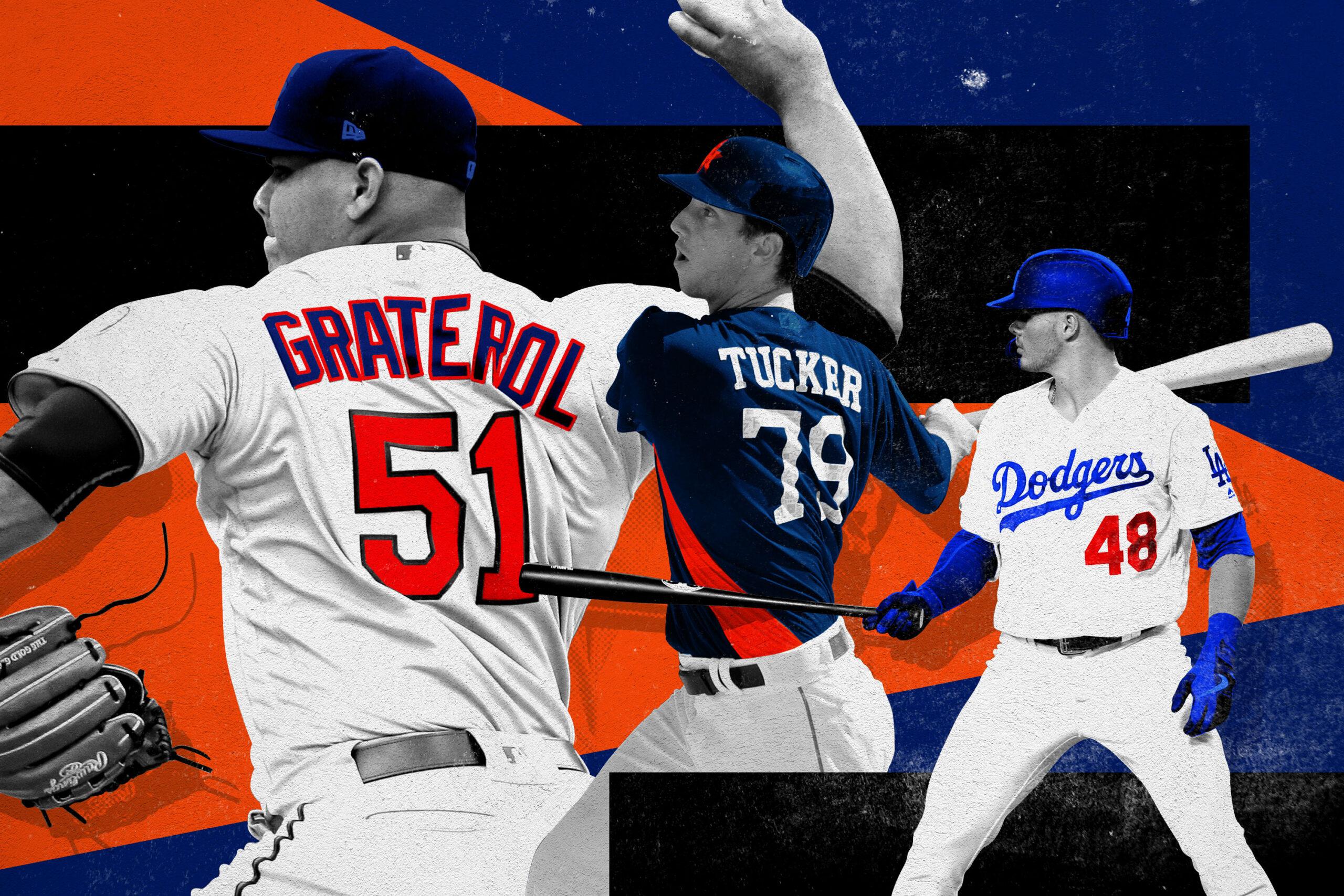
With the turn to a new page of the calendar on September 1, MLB rosters expanded—for the final time—to fit 40 players. Among the new players called up this week are a variety of depth catchers and relievers, players returning from long-term injuries, and old friends making their way around the league (Kyle Barraclough is a Giant now! Drew Butera’s a Rockie! Gorkys Hernández plays in Boston!).
Of more interest to close pennant watchers, though, is another class of September promotee: the actual prospect making his way onto a contending roster, with the potential to not just audition for an expanded role next season, but to make an impact as soon as this fall. Last week, we looked at the players returning from injury in September who could swing an October series. There aren’t nearly as many prospects who can say the same, but that scarcity makes the following players all the more special, and worth watching over the remainder of the regular season. Here are the three kinds of September prospect call-ups for a contender, along with the 2019 players who belong in each group.
The Superstar in Waiting
In early September, the Dodgers promoted a lefty-hitting middle infielder that they had taken in the first round of the MLB draft three years earlier. They did the exact same thing in 2015, and that time, Corey Seager proved himself worthy of an October roster spot by hitting .337/.425/.561 for a month. He eventually started four of the Dodgers’ five playoff games.
This year, the player who fits those criteria is Gavin Lux (FanGraphs’ no. 9 prospect), the most exciting new MLB player this month—and a player with a real shot of helping the Dodgers this postseason. Originally seen as a glove-first prospect, Lux benefited from physical growth and a lift-oriented swing change in the minors, and there transformed into the next great hitter for a club full of them. Lux OPSed .896 in Double-A this year to earn a promotion of one level, then hit an outrageous .392/.478/.719 in 49 Triple-A games to push his way to the majors. Read those numbers again: .392/.478/.719. That’s a bonkers stat line at any level of baseball, in any offensive environment.
Lux has played mostly shortstop throughout his pro career, though he’s moved to second base with the Dodgers to accommodate Seager. That’s OK, and perhaps a first step on his longer-term path, anyway, as his worst “tool” grade belongs to his arm on defense. A move to second base should temper any such concerns.
Manager Dave Roberts said Lux will be the club’s second baseman against righties this month, which makes sense given Max Muncy’s injury and the fact that the Dodgers’ other second base options—Enrique Hernández, Chris Taylor, Jedd Gyorko, and Kristopher Negrón—are all right-handed hitters. Even when Muncy returns from his broken wrist, Lux could still find playing time as a platoon hitter in the playoffs; Muncy could slide to first base, with Cody Bellinger rotating to the outfield, where he rates as one of the majors’ best defensive right fielders. The Dodgers have an embarrassment of position player riches, such that they don’t need Lux to field a capable lineup 1-through-8 and contend for a title. But if he translates even a fraction of his minor league success to the majors this month, it’s hard to imagine L.A. not including him on the playoff roster.
The Position Player Who Could Force Himself Onto a Playoff Roster
The other notable position player prospects promoted by contenders this month don’t quite reach Lux’s luster, but they could play their way into a depth role over the next few weeks. In his first career MLB game on Wednesday, Athletics catcher Sean Murphy (FanGraphs’ no. 30 overall prospect) blasted a 95 mile-per-hour fastball 409 feet to right center—and in so doing showed why he’s already the best offensive catcher in the Oakland organization.
Oakland’s other catchers have struggled at the plate this season, as Josh Phegley totes an 84 wRC+ (meaning he’s hit 16 percent worse than the league average) and backup Chris Herrmann is at a 50 wRC+ as he struggles to clear the Mendoza line. Murphy, meanwhile, has crushed upper-level minor league pitching for the last two seasons, when he hasn’t been injured, and has started growing into his power this year, too, with 10 home runs and a .625 slugging percentage in 31 Triple-A games.
Murphy isn’t just a promising hitter; he also projects as an above-average defensive catcher, with one of the top arms among catching prospects and solid framing numbers in his minor league career. The issue for Murphy in terms of 2019 playing time is the same issue that afflicts all catchers who join a team late in the season. He’s not just adjusting to a higher level, to facing new and better pitchers, and to the intensity of a playoff race—he also must learn the tendencies and develop a rapport with a staff full of his own pitchers to better call their games and frame their throws. That’s a challenge for any player, let alone a rookie, so even if Murphy outhits Phegley and Herrmann the rest of the way, Oakland still might not thrust him into a meaningful role.
Another touted youngster in a precarious situation is Houston outfielder Kyle Tucker (FG’s no. 15 prospect), who’s back in the majors after a topsy-turvy last two years. Long considered a future star, Tucker was the fifth overall pick in the 2015 draft—and the first outfielder taken, two spots ahead of Andrew Benintendi. He hit in Low-A, and High-A, and Double-A, and Triple-A, and then he ran into an MLB wall, sputtering to a .141/.236/.203 line in 28 games with Houston last season. Plenty of players have struggled upon first exposure to the majors before succeeding later on, but the fact that the Astros decided to leave Tucker in the minors for all of 2019 until now suggests that the Houston front office might not view its prospect as highly as outside observers.
Indeed, Tucker has been a streaky hitter in Triple-A this year. And although his overall numbers look enticing in a vacuum—34 homers, 30 steals, and a .266/.354/.555 slash line—they appear significantly less impressive when considering the context, as Triple-A leagues adopted the juiced MLB ball this year and saw offense skyrocket as a result. The average Pacific Coast League hitter this season hit .277/.354/.477, or basically Tucker’s output with a bit less power; among 78 qualified hitters, Tucker ranked just 25th in OPS.
Still, Tucker could find a place on this Astros team, particularly given Josh Reddick’s underperformance in right field (84 wRC+ this year, including a near-league-worst 45 since the All-Star break). Unlike Oakland, which is mired in a tight playoff race, Houston should coast to another division title, so the Astros can afford to give Tucker regular at bats this month to see if he is worth keeping through October, even as a bench bat. As if the Astros’ league-best lineup weren’t imposing enough already.
The Pop-up Shutdown Reliever
The largest contingent of notable call-ups fits the mold of many an October youngster past. Francisco Rodríguez debuted on September 18, 2002 and pitched in a grand total of five regular-season games before putting on a phenomenal postseason show for the champion Angels: a 5-1 record, 1.93 ERA, and 28 strikeouts in 18 2/3 innings. Only Andrew Miller in 2016 has ever struck out more batters in a single postseason as a reliever.
In addition to Rodríguez, who is a career reliever, another common type is the future starter who first dips his toes into MLB waters as a reliever. David Price performed this role for the 2008 Rays, debuting on September 14 and then, just one month later, closing out Game 7 of the ALCS for his first and only career save.
Twins righty Brusdar Graterol (FG’s no. 68 prospect) is 2019’s best bet to pull off that feat. The Venezuelan righty, who celebrated his 21st birthday last week, might be a future starter, or he might end up in relief because of a long history of injuries. He has all the traits of an elite reliever, though, with a fastball that sits at 99 miles per hour and often reaches triple digits, as well as an above-average slider and—like seemingly all closers at a young age—some track record of spotty command.
For this season, Graterol could easily find a spot in the Twins bullpen before the playoffs. Closer Taylor Rogers has developed into an excellent reliever capable of retiring hitters on both sides, but the pen’s righties are all more good than great. Don’t be surprised if Graterol ends up pitching important set-up innings in the ALDS.
Fudging the dates a bit adds Oakland’s A.J. Puk (no. 20 on the Top 100) to the list as well, after he made his MLB debut on August 21. The hard-throwing lefty has returned from a 2018 Tommy John surgery and is in the bullpen for now, despite his long-term potential as a starter. Puk hasn’t pitched much thus far, appearing in three games and none in September, but fellow southpaw Jake Diekman has struggled since moving to Oakland in a July trade (11 walks and seven earned runs in 11 2/3 innings), so there might be room for Puk as a high-leverage lefty down the stretch.
Other candidates to pitch their way onto a playoff roster—even if they’re less likely than Graterol or Puk to do so—are the Cubs’ Adbert Alzolay, an inconsistent right-hander who has lost some prospect sheen; the Rays’ Anthony Banda, a 26-year-old lefty who has returned from Tommy John surgery to the MLB level, where has has experienced success (35 strikeouts vs. 13 walks; 3.26 FIP) in limited playing time in the past; and the Cardinals’ Junior Fernández, a righty with a 97 mile-per-hour fastball and a 1.52 ERA across 65 innings and three minor league levels in 2019.
Fernández in particular inspires interest, as he might have the least long-term potential of this group but the most natural path to an October role this season. The Cardinals’ bullpen is a strange unit: Its top two pitchers before the season were Jordan Hicks, who suffered a season-ending injury in June, and Andrew Miller, who has his worst underlying numbers (5.47 FIP, with elevated walk and home run rates) since converting to relief. Yet the Cardinals still rank first among all bullpens in FIP and second in ERA. They thus don’t need another reliever, but they also don’t have any standouts beyond new closer (and converted starter) Carlos Martínez and Giovanny Gallegos, so a strong September could allow Fernández to quickly climb the bullpen hierarchy. He’s off to a strong start: a 2.84 ERA and 30 percent strikeout rate in six MLB games, which includes a brief stint in August.
More promising pitchers might materialize at the MLB level as the month continues; remember, Rodríguez and Price didn’t debut until the middle of September before their playoff exploits. The likes of the Athletics’ Jesus Luzardo (FG’s no. 24 prospect) and the Yankees’ Deivi Garcia (no. 64) are pitching in the Triple-A playoffs at the moment but could be promoted before month’s end and make an instant impact.
Luzardo, who came to Oakland in the Sean Doolittle–Blake Treinen trade, has a 2.51 ERA and 32.8 percent K rate in the minors this season as he rehabs separate injuries to his rotator cuff and lat muscle. Garcia has flashed some of the top strikeout numbers in the entire minor leagues in 2019, with 165 strikeouts in only 111 1/3 innings (a 34.0 percent rate, akin to Max Scherzer at the MLB level). He’s been pitching in relief recently, as New York both limits his innings and prepares him for a possible promotion to the majors, where—like other prospects on this list, and other memorable pitchers from playoffs past—he could boost his team’s postseason fortunes.
Stats through Wednesday’s games.

